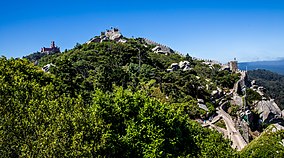| Sintra-Cascais Natural Park | |
|---|---|
IUCN category V (protected landscape/seascape) | |
 Castle of the Moors with the Pena Palace in the background, Sintra Mountains. | |
| Location | Lisbon District, Portugal |
| Coordinates | 38°47′58″N 9°26′32″W / 38.79944°N 9.44222°W |
| Area | 144.51 km2 (55.80 sq mi)[1] |
| Max. elevation | 528 m (1,732 ft) |
| Min. elevation | sea-level |
| Established | October 15, 1981 |
| Visitors | 43,512 (in 2017-2020 (average))[2] |
| Governing body | ICNF |
The Sintra-Cascais Natural Park is a park on the Portuguese Riviera, one of the 13 Natural Parks of Portugal. While only established in 1994 as a Natural Park by the Portuguese Government, it has been protected since 1981. Its area is approximately 145 km2. The park includes the Serra de Sintra Mountain Range but extends all the way to the coast and Cabo da Roca, continental Europe's westernmost point. It contains the Castle of the Moors. Located within 25 km of Lisbon, the Sintra-Cascais Natural Park is a popular tourism area, with many different individual historical and natural sites and attractions. Sintra and Cascais are towns and municipalities in the Lisbon / Estoril Coast.
Attractions within the Park
[edit]- Anta de Adrenunes
- Azenhas do Mar
- Cabo da Roca
- Castle of the Moors
- Chalet and Garden of the Countess of Edla
- Convent of the Capuchos (Sintra) (Convent of the Friars Minor Capuchin)
- Cresmina Dune
- Palace of Sintra
- Pena Palace
- Praia do Guincho (Guincho Beach)
- Monserrate Palace
- Quinta da Regaleira
- Quinta da Ribafria
- Ramalhão Palace
- Sanctuary of Peninha
- Seteais Palace
Photo Gallery
[edit]-
A sign after entering the park, near Cascais.
-
Guincho, a well known beach near Cascais, with Cabo da Roca seen at distance.
-
Cabo da Roca, near Sintra.
-
The Pena Palace, standing on a hill above Sintra.
References
[edit]- ^ "Sintra-Cascais | DOPA Explorer". dopa-explorer.jrc.ec.europa.eu. Retrieved 31 May 2021.
- ^ "Número de visitantes que contactaram as áreas protegidas". ICNF. Retrieved 31 May 2021.
External links
[edit]- Official Site at the (Portuguese) Institute for Nature Conservation (Portuguese language)





Well, that’s interesting to know that Psilotum nudum are known as whisk ferns. Psilotum nudum is the commoner species of the two. While the P. flaccidum is a rare species and is found in the tropical islands. Both the species are usually epiphytic in habit and grow upon tree ferns. These species may also be terrestrial and grow in humus or in the crevices of the rocks.
View the detailed Guide of Psilotum nudum: Detailed Study Of Psilotum Nudum (Whisk Fern), Classification, Anatomy, Reproduction